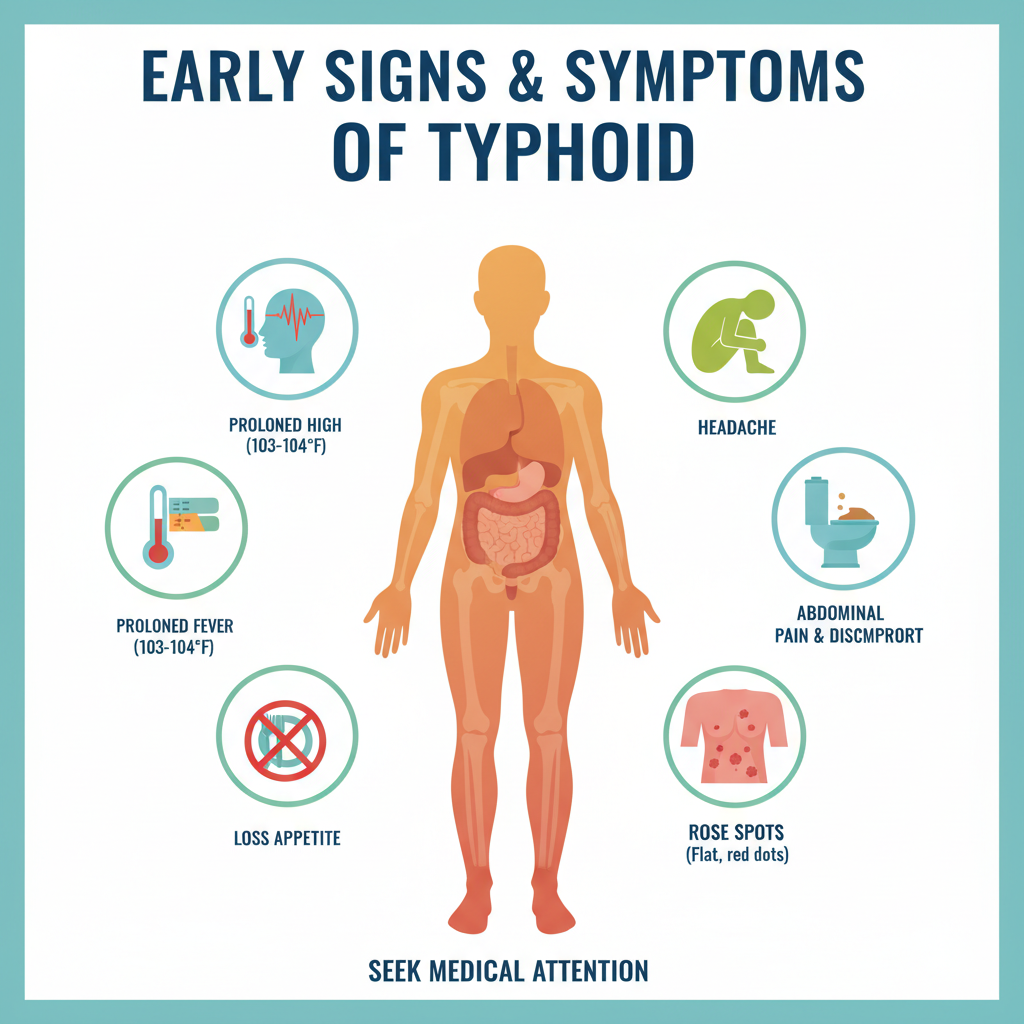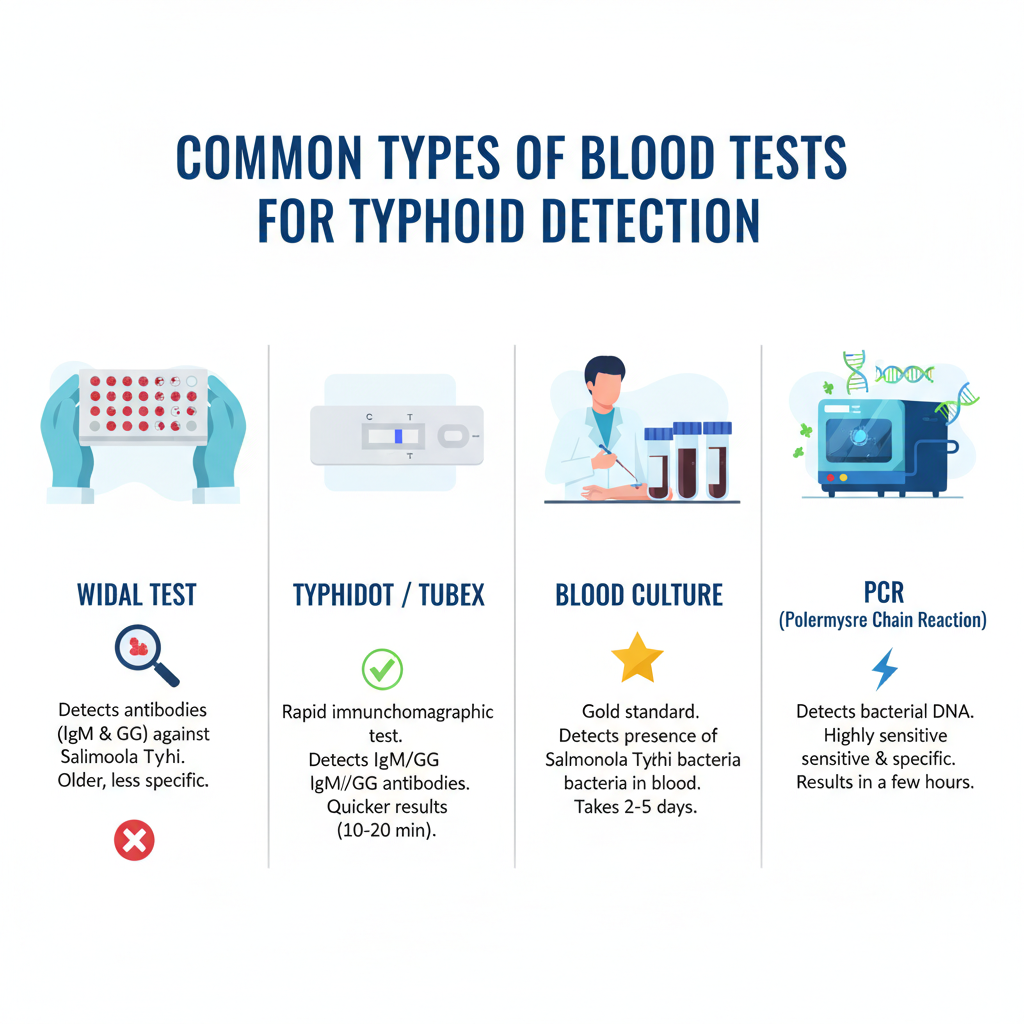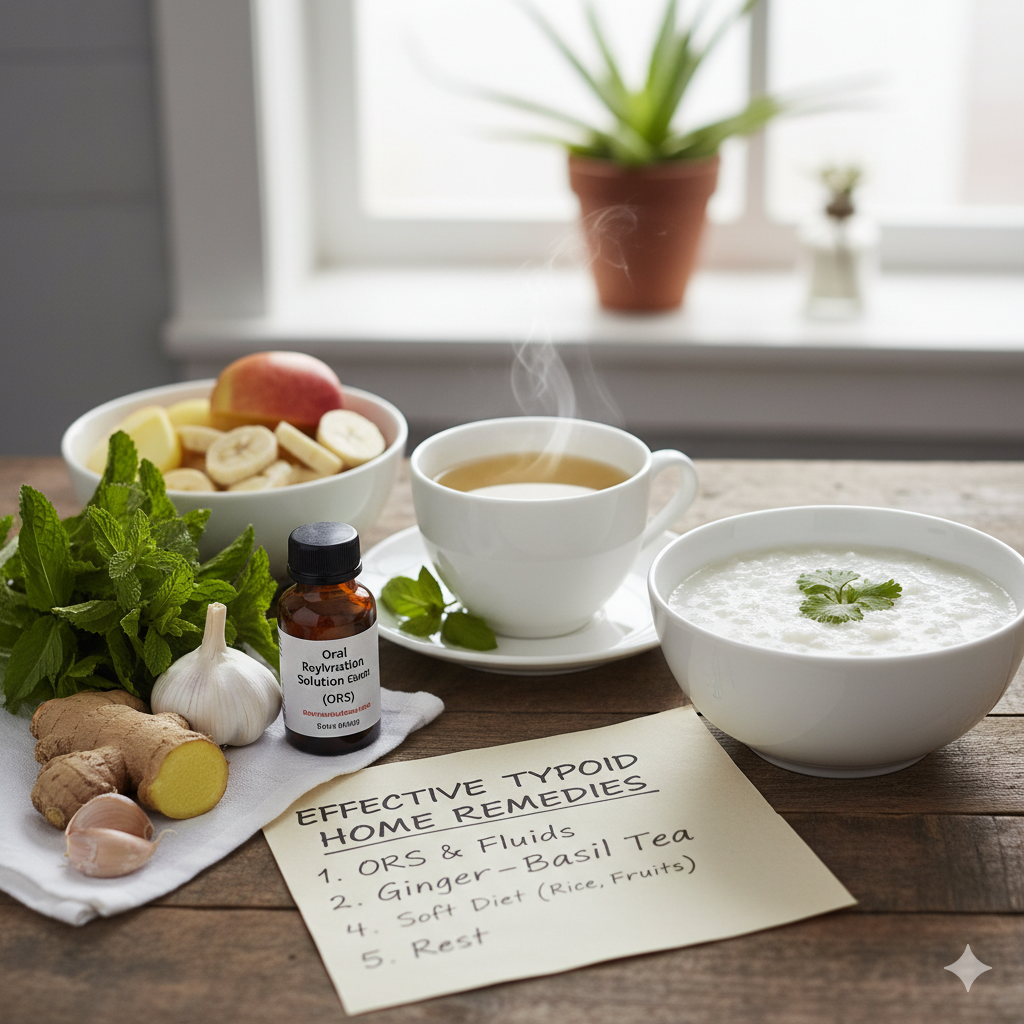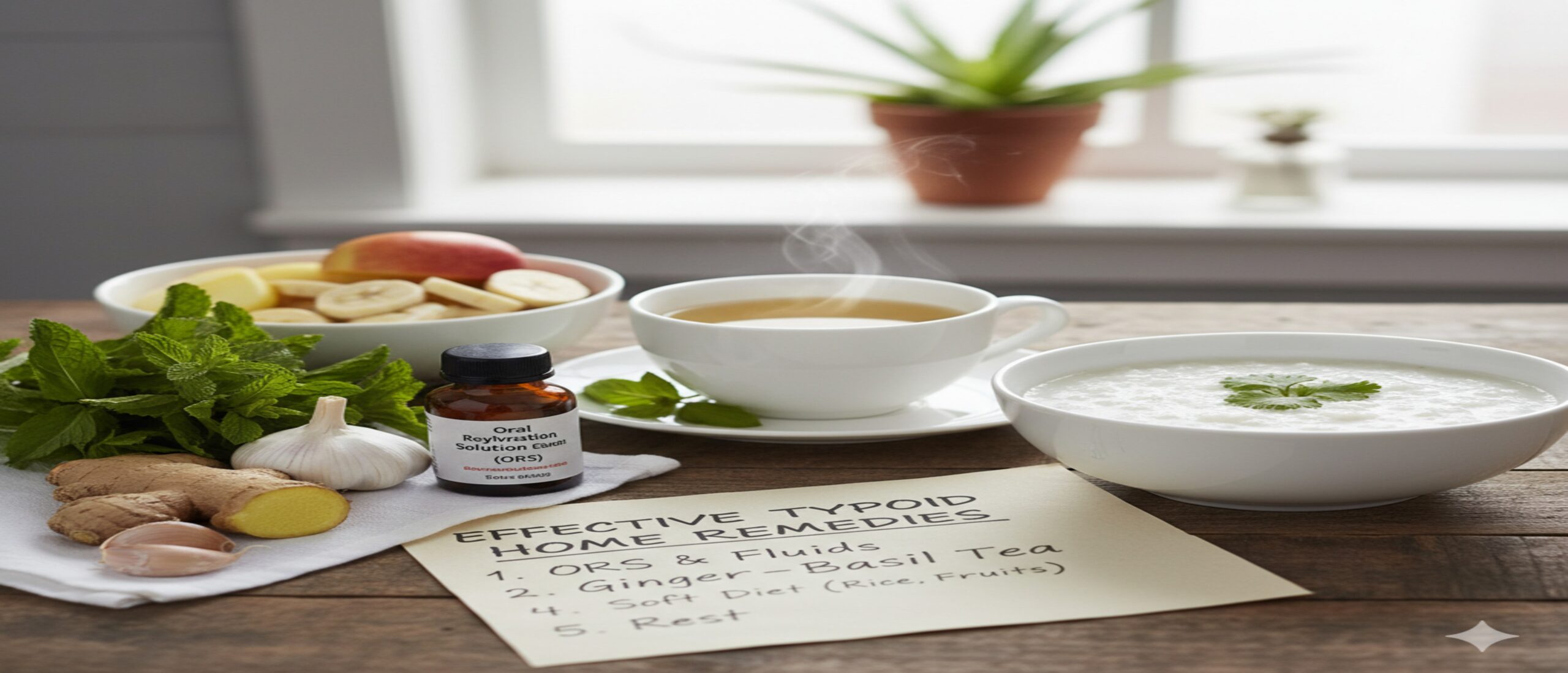Introduction to Typhoid Fever
Typhoid fever remains one of the most common bacterial infections in developing countries, often caused by consuming contaminated food or water. This illness, primarily triggered by Salmonella Typhi bacteria, can cause prolonged fever, weakness, abdominal pain, and other complications if not treated on time. Understanding typhoid is crucial because it can easily spread within families or communities if proper hygiene and preventive measures aren’t followed.
Typhoid affects both children and adults, but it is more prevalent in areas with inadequate sanitation. Unlike common fevers that subside in a few days, typhoid fever tends to persist and may escalate if ignored. The infection begins in the intestines and eventually spreads to the bloodstream, affecting multiple organs. Therefore, knowing the causes, symptoms, and available diagnostic methods is essential before starting any home treatment.
Before you consider home remedies, it’s important to confirm the diagnosis through blood tests for typhoid. While natural methods can support recovery and reduce symptoms, accurate testing ensures that the illness is indeed typhoid and not another infection mimicking its signs. Let’s explore the early symptoms and how blood tests play a vital role in managing this condition effectively.
Early Signs and Symptoms of Typhoid

Typhoid fever often starts subtly but can worsen quickly. The first signs may resemble a mild viral infection, but they intensify over time. Common symptoms include a continuous high fever (often reaching 104°F or higher), severe headache, abdominal discomfort, fatigue, muscle pain, and loss of appetite. In some cases, patients may also experience constipation or diarrhea depending on their immune response and diet.
A distinct sign of typhoid is a gradual rise in fever over several days. Unlike sudden fevers, typhoid fever slowly builds up and refuses to go down without proper treatment. Some patients also develop rose-colored spots on their chest or abdomen — small red rashes caused by bacterial toxins in the bloodstream.
If these symptoms persist for more than three days, it’s crucial to undergo typhoid blood tests for confirmation. Ignoring these signs or mistaking them for flu can lead to serious complications such as intestinal perforation, dehydration, or even sepsis. Early detection through testing, followed by natural remedies and rest, can help manage typhoid safely at home.
Importance of Early Blood Tests for Typhoid Diagnosis

Blood tests are the most reliable way to confirm typhoid fever. Since the symptoms can resemble those of malaria, dengue, or viral infections, testing ensures accurate diagnosis and prevents misuse of antibiotics. Early blood tests for typhoid can detect the presence of Salmonella Typhi in the bloodstream, allowing doctors or health practitioners to recommend the right treatment plan.
Timely testing also helps monitor how the infection is progressing. If typhoid is detected early, mild cases can often be managed with home care, hydration, and diet adjustments under guidance. However, in severe cases, blood test results may indicate the need for medical intervention.
Commonly used typhoid tests include the Widal test, Typhidot test, and blood culture. These tests help identify antibodies or bacterial growth in the blood, confirming infection. It’s always advisable to test before beginning treatment, as misdiagnosis can delay recovery or cause unnecessary complications.
Common Types of Blood Tests for Typhoid Detection

When typhoid fever is suspected, blood tests are the gold standard for confirming the infection. They not only detect the Salmonella Typhi bacteria but also help track the body’s immune response during treatment. Here are the most common blood tests for typhoid and what they reveal about your health condition.
- Widal Test:
This is one of the oldest and most frequently used diagnostic tests for typhoid fever. It works by identifying antibodies produced by your body in response to Salmonella Typhi infection. The test measures two types of antibodies: “O” (somatic) and “H” (flagellar). A higher antibody count indicates active infection or exposure to typhoid bacteria. However, since these antibodies may stay in the blood for months after recovery, the Widal test must be interpreted carefully. - Typhidot Test:
The Typhidot test is a rapid diagnostic method that detects IgM and IgG antibodies against Salmonella Typhi. IgM antibodies appear early during infection, while IgG antibodies remain longer, indicating either a current or past infection. This test provides results within a few hours and is highly useful in regions where quick diagnosis is needed. - Blood Culture Test:
The blood culture test is considered the most accurate for identifying typhoid fever. It isolates Salmonella Typhi directly from the patient’s blood sample collection. Though it may take 2–3 days for results, it provides a definitive diagnosis. Early blood culture tests are critical because the bacteria are more detectable in the bloodstream during the first week of infection. - PCR (Polymerase Chain Reaction) Test:
PCR is a molecular test that detects the DNA of Salmonella Typhi. It’s faster and more precise than traditional methods, identifying even small traces of bacterial DNA. This test is particularly useful when other tests give inconclusive results.
All these blood tests for typhoid play a vital role in confirming the illness before beginning any home remedy or antibiotic course. Getting the right test done ensures effective treatment and prevents resistance to medication.
Understanding Typhoid Bacteria: Salmonella Typhi
Typhoid fever is caused by Salmonella enterica serotype Typhi, a rod-shaped, gram-negative bacterium. It thrives in the intestines and spreads through contaminated food or water. Once ingested, the bacteria invade the intestinal walls, enter the bloodstream, and multiply rapidly, releasing toxins that cause prolonged fever and inflammation.
The danger of Salmonella Typhi lies in its ability to hide inside white blood cells and evade the immune system. This makes the infection persistent and difficult to eradicate without proper diagnosis and treatment. Over time, the bacteria can travel to vital organs like the liver, spleen, and bone marrow, leading to severe complications if untreated.
Another challenge is antibiotic resistance. Due to the overuse of certain drugs, many Salmonella Typhi strains have developed resistance, making treatment more difficult. This is why confirming typhoid through accurate blood tests before starting any medication or home remedy is critical.
Home remedies can help manage symptoms, but understanding how the bacteria works allows you to take better preventive measures. Good hygiene, safe drinking water, and a strong immune system are your best defenses against this stubborn microorganism.
Effective Typhoid Home Remedies for Treatment at Home

Once typhoid is diagnosed through blood tests, mild cases can often be managed with proper rest, hydration, and diet at home. These effective typhoid home remedies focus on boosting immunity, managing fever, and reducing bacterial toxins naturally.
Home remedies don’t replace prescribed antibiotics but serve as supportive care to enhance recovery. They also help manage the side effects of typhoid, such as dehydration, fatigue, and appetite loss. Here are some of the most effective methods to treat typhoid at home:
- Hydration: Typhoid causes severe dehydration due to high fever and diarrhea. Drink water, coconut water, electrolyte solutions, and clear soups regularly.
- Light Diet: Soft, easily digestible foods like rice gruel, mashed potatoes, and boiled vegetables reduce pressure on the intestines.
- Herbal Remedies: Basil, garlic, and cloves possess antibacterial and immune-boosting properties.
- Natural Coolants: A cold compress or sponging helps control high body temperature naturally.
- Rest and Hygiene: Adequate rest supports faster healing, while good hygiene prevents reinfection.
Remember, if symptoms worsen—such as persistent fever, confusion, or vomiting—seek medical help immediately. Home remedies are effective for mild cases but not substitutes for medical treatment in severe infections.
Hydration Therapy: The First Step in Typhoid Home Treatment

Hydration therapy is the foundation of typhoid treatment at home. The infection causes continuous fever, leading to heavy sweating and water loss. In severe cases, diarrhea can worsen dehydration, making the patient weak and dizzy. Keeping your body hydrated helps regulate temperature, maintain blood volume, and flush out toxins faster.
Best Hydrating Drinks for Typhoid Patients:
- Coconut Water: A natural electrolyte-rich drink that replenishes lost minerals.
- ORS Solution: Helps restore salt and fluid balance, preventing dehydration.
- Lemon Water: Provides vitamin C and helps reduce fatigue.
- Rice Gruel (Kanji): Soothes the stomach and is easy to digest.
- Herbal Teas: Mint or ginger tea helps calm the digestive system.
Avoid caffeinated beverages and sodas as they can worsen dehydration. Instead, drink water frequently in small sips throughout the day. Hydration therapy, when combined with rest and light meals, speeds up the healing process dramatically.
Diet Plan for Typhoid Recovery at Home

Diet plays a key role in typhoid recovery at home. Since typhoid affects the intestines, eating heavy or oily food can worsen symptoms. A soft, bland, and nutrient-rich diet is essential to regain strength and support the immune system.
Foods to Eat:
- Boiled rice and lentil soup: Gentle on the stomach and easy to digest.
- Mashed potatoes or boiled vegetables: Provide energy without taxing digestion.
- Bananas and applesauce: Help prevent diarrhea and provide quick energy.
- Homemade broths: Supply essential vitamins and minerals lost during fever.
Foods to Avoid:
- Spicy or fried foods that irritate the intestines.
- Dairy products that can cause bloating.
- Raw salads that may contain harmful bacteria.
- High-fiber foods that are difficult to digest.
Eating small, frequent meals rather than heavy portions helps the body recover faster. The goal is to nourish without overloading the digestive system. Always ensure that food and water are boiled or filtered to prevent reinfection.
Herbal Remedies for Typhoid Treatment at Home
When dealing with typhoid fever, herbal remedies can offer natural support to reduce fever, fight bacteria, and strengthen immunity. These typhoid home remedies have been used for centuries and are backed by traditional medicine for their healing properties. However, they should be used alongside medical advice, especially if the infection is moderate to severe.
- Basil (Tulsi):
Basil is one of the most effective herbs for treating typhoid symptoms at home. Its antibacterial and antibiotic properties help kill Salmonella Typhi bacteria. You can boil 10–15 basil leaves in a cup of water, add a spoon of honey, and drink it two to three times a day. Basil also helps reduce fever and improves digestion. - Garlic:
Garlic is a powerful natural antibiotic. It boosts immunity and helps the body eliminate toxins. Eating two crushed garlic cloves on an empty stomach each morning strengthens your immune response and fights infection. You can also mix garlic paste with honey or milk for a milder flavor. - Cloves:
Clove oil contains eugenol, an antiseptic compound that helps in fighting bacteria and inflammation. Boil a few cloves in water and drink this tea twice a day. It soothes the throat, reduces fever, and helps with digestion. - Ginger and Turmeric:
Both ginger and turmeric have strong anti-inflammatory properties. A warm tea made with grated ginger, a pinch of turmeric, and honey can boost immunity and soothe stomach discomfort. Turmeric’s curcumin compound is also known to fight bacterial growth naturally. - Neem Leaves:
Neem has natural antibacterial properties and is widely used in Ayurvedic treatments for infections. Boil a few neem leaves in water, strain, and drink the infusion daily to purify the blood and aid recovery.
These herbal remedies for typhoid treatment at home can help alleviate symptoms and speed up recovery. Always ensure you’re using fresh, clean herbs and maintain proper hygiene during preparation.
Fruits and Juices That Boost Immunity During Typhoid
Fruits and natural juices play a vital role in restoring strength during typhoid recovery. They’re easy to digest, rich in vitamins, and provide hydration—all essential during fever. A strong immune system is your best defense against Salmonella Typhi, and the right fruits can help rebuild it faster.
- Bananas:
Bananas are gentle on the stomach and provide instant energy. They contain pectin, which helps in controlling diarrhea—a common symptom during typhoid. Eating one or two ripe bananas daily can restore lost nutrients and maintain electrolyte balance. - Apples:
Apple pulp or applesauce is highly recommended for typhoid patients. Apples are rich in fiber, help detoxify the body, and support digestion. Blending apples into juice with a pinch of cinnamon can also soothe fever-related fatigue. - Papaya:
Raw papaya is a traditional remedy for reducing fever. It helps in lowering body temperature and improving digestion. Boil grated papaya with water to make a herbal decoction or enjoy it as fresh juice for quick recovery. - Pomegranate Juice:
Pomegranate is packed with antioxidants and helps in maintaining hemoglobin levels. Drinking pomegranate juice strengthens the immune system and restores lost energy. - Orange Juice:
Oranges are rich in vitamin C, which strengthens immunity and helps fight infection. They also provide hydration and reduce inflammation in the body.
While fruits are beneficial, always consume them peeled and freshly washed to avoid further bacterial contamination. Avoid packaged juices and opt for homemade versions instead.
The Role of Apple Cider Vinegar in Typhoid Fever Control
Apple cider vinegar (ACV) is another effective typhoid home remedy that helps in reducing high fever and detoxifying the body naturally. Its acidic nature draws heat from the body, bringing down fever safely. Moreover, ACV helps in balancing the body’s pH levels and replenishing minerals lost due to sweating and fever.
How to Use Apple Cider Vinegar for Typhoid:
- ACV and Water Mix: Mix one tablespoon of raw, unfiltered apple cider vinegar in a glass of warm water. Drink this before meals twice a day.
- ACV Sponge Bath: Add half a cup of ACV to a bowl of cool water. Soak a clean cloth in the mixture and gently sponge the patient’s body to bring down the temperature.
The potassium in ACV helps replenish electrolytes, while its antimicrobial properties fight bacteria internally. However, it should always be diluted—pure ACV can be too acidic and may irritate the throat or stomach.
This simple yet powerful remedy can be a great addition to your home treatment routine for typhoid fever.
Rest and Hygiene Practices for Typhoid Recovery at Home
When recovering from typhoid fever, rest and hygiene are just as crucial as medication or diet. The body needs time to fight the infection, rebuild energy, and restore immunity. Overexerting yourself too soon can delay healing or trigger relapse.
- Importance of Rest:
During typhoid, the immune system is under immense stress. Getting plenty of rest allows your body to focus its energy on fighting Salmonella Typhi. It’s recommended to sleep for at least 8–10 hours a day and avoid physical strain until you’ve regained full strength. - Maintaining Hygiene:
Typhoid spreads through contaminated food and water, so maintaining personal and kitchen hygiene is essential. Wash hands frequently, disinfect utensils, and always use boiled or filtered water for drinking and cooking. - Clean Surroundings:
Keep your living area clean and ensure proper waste disposal. Avoid eating street food or unwashed fruits during recovery. Even after symptoms subside, the bacteria can remain in your system for several weeks, making hygiene vital to prevent reinfection. - Isolation and Utensil Care:
If someone in the family has typhoid, their utensils, clothes, and towels should be washed separately. This prevents the spread of infection to others.
Following these rest and hygiene practices at home ensures not only quicker recovery but also protects your family from catching the infection.
Using Cold Compress and Natural Cooling Techniques
High fever is the most exhausting symptom of typhoid fever. Instead of relying solely on medication, natural cooling techniques can safely bring down body temperature and provide relief.
Cold Compress Method:
Dip a soft cloth in cool (not ice-cold) water, wring out the excess, and place it on the patient’s forehead, neck, and armpits. Replace it every few minutes. This helps the body dissipate heat naturally.
Other Cooling Remedies:
- Basil and Mint Infused Water: Drinking or sponging with mint or basil water cools the body gently.
- Hydration with Lemon Water: Lemon water helps detoxify the body and keeps fever under control.
- Room Temperature Control: Keep the room cool and well-ventilated. Avoid covering the patient with heavy blankets unless they are shivering.
Avoid using ice directly on the skin as it can cause shock or chills. Natural cooling is safer and more effective in maintaining comfort during fever.
When to Repeat Typhoid Blood Tests During Home Recovery
After starting treatment or home remedies for typhoid, it’s important to monitor your progress through follow-up blood tests for typhoid. Typhoid fever can linger in the body even after symptoms improve, and the bacteria may remain dormant, causing relapse if left unchecked. Regular testing ensures the infection has been completely cleared and that your recovery is genuine, not temporary.
- First Follow-Up Test:
Typically, doctors or health practitioners recommend a repeat blood test about 7–10 days after initial treatment begins. This helps confirm that the Salmonella Typhi count has decreased and the antibiotics or remedies are working effectively. - Second Follow-Up Test:
If symptoms persist, such as mild fever, fatigue, or abdominal pain, a second test may be advised after three weeks. Persistent antibodies or bacteria in the blood may indicate incomplete recovery or antibiotic resistance. - Post-Recovery Confirmation:
Even after you feel better, it’s wise to get a final typhoid blood test to confirm total elimination of the bacteria. In some cases, patients may become chronic carriers, meaning they can spread the bacteria through stool or urine even after recovery. - Monitoring Family Members:
If anyone in the household shared food or water with the patient during the illness, they should also consider testing. Typhoid spreads easily within families, especially where sanitation or water safety is compromised.
Monitoring through timely blood tests helps prevent reinfection and ensures your home remedies and diet plan are working efficiently. Never skip these follow-ups—catching lingering bacteria early saves you from a long-term relapse.
Precautions and Prevention Tips for Typhoid Fever
While home remedies and blood tests help manage typhoid, prevention remains the best strategy. Typhoid is a water- and food-borne disease, so maintaining hygiene and following preventive habits can protect you and your family from infection.
- Drink Only Safe Water:
Always drink boiled or filtered water. Avoid ice from unknown sources and avoid beverages made with untreated water. - Eat Hygienic Food:
Eat freshly cooked food, and avoid raw or unpeeled fruits and vegetables, especially from street vendors. Wash all produce thoroughly before eating. - Maintain Hand Hygiene:
Wash your hands with soap and clean water before eating and after using the toilet. Hand sanitizers can be used when outside. - Vaccination:
Vaccines for typhoid are available and recommended for individuals living in or traveling to high-risk areas. Vaccination offers protection for several years and significantly lowers infection risk. - Sanitation and Waste Disposal:
Ensure proper sewage and waste disposal systems at home. Avoid open defecation, which contaminates the environment and spreads bacteria. - Boost Immunity Naturally:
A strong immune system acts as a natural barrier against infections. Eat a balanced diet, include probiotics, exercise regularly, and get enough sleep. - Avoid Self-Medication:
Do not start antibiotics without consulting a healthcare provider. Misuse of antibiotics leads to drug-resistant strains of Salmonella Typhi, making future infections harder to treat.
Following these preventive tips alongside proper hygiene ensures long-term protection against typhoid. Prevention truly is better—and easier—than cure.
Conclusion: Combining Home Remedies with Proper Diagnosis
Recovering from typhoid fever is a delicate process that demands both accurate diagnosis and supportive home care. While home remedies like herbal teas, hydration, and dietary adjustments provide comfort and boost immunity, typhoid blood tests are essential for confirming the infection and tracking recovery progress. Ignoring medical testing can lead to misdiagnosis or prolonged illness, while over-reliance on medication without rest and nutrition can slow healing.
The key is balance: combine traditional wisdom with scientific accuracy. Regular hydration, light and nutritious meals, adequate rest, and proper hygiene create an ideal environment for recovery. At the same time, scheduled blood tests ensure that Salmonella Typhi is fully eliminated from your body.
With consistent care and awareness, you can treat typhoid safely at home and prevent it from returning. Your health is in your hands—guard it through knowledge, prevention, and disciplined self-care.
FAQs About Typhoid Home Remedies and Blood Tests
- Can typhoid be treated completely at home?
Mild cases can often be managed at home with proper rest, hydration, and a healthy diet. However, medical diagnosis through blood tests and free doctor consultation is essential before starting any treatment. - How long does it take to recover from typhoid fever?
Recovery usually takes 10 to 14 days, but weakness may persist for several weeks. Proper rest and follow-up blood tests help confirm complete recovery. - Which is the most accurate blood test for typhoid?
The blood culture test is the most reliable as it directly identifies Salmonella Typhi. PCR tests also provide high accuracy, especially in early infection stages. - Are herbal remedies safe for typhoid?
Yes, most herbal remedies like basil, garlic, and cloves are safe when used correctly. However, they should complement—not replace—medical treatment. - How can I prevent typhoid from recurring?
Maintain good hygiene, drink only clean water, complete the full course of prescribed medicine, and go for repeat blood tests to confirm the infection is gone.


Leave a Reply